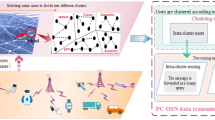Abstract
In social networks, nodes should analyze communication area during data transmission and find suitable neighbors to perform effective data classification transmission. This is similar to finding certain transmission destinations during data transmission with mobile devices. However, cache space with node in social opportunistic networks is limited, and waiting for destination node could also cause end-to-end delay. To improve the transmission environment, this study established a node recognition method for assessment probability, to satisfy the priority adjustment for the high probability nodes of cache, and then cache space should be reconstructed. To avoid accidentally deleting cached data, the cache task of the node is shared through the neighbor node cooperation, and the effective data transmission is performed. Through experiments and the comparison of social network algorithms, the proposed scheme improves delivery ratio by 82% and reduces delay by 74% with the traditional algorithms on average.










Similar content being viewed by others
References
Hu, Y., & Liu, A. (2015). An efficient heuristic subtraction deployment strategy to guarantee quality of event detection for WSNs. The Computer Journal, 58(8), 1747.
Guo, H., Wang, X. W., Huang, M., et al. (2012). Adaptive epidemic routing algorithm based on multi queue in DTN. Journal of Chinese Computer Systems, 33(4), 829–832.
Wang G, Wang B, Gao Y (2010) Dynamic spray and wait routing algorithm with quality of node in delay tolerant network. In: International conference on communications and mobile computing. IEEE, pp. 452–456.
Jia, W. U., Chen, Z., & Zhao, M. (2017). Effective information transmission based on socialization nodes in opportunistic networks. Computer Networks, 129, 297–305. https://doi.org/10.1016/j.comnet.2017.10.005.
Sheu, J. P., & Chuo, Y. C. (2016). Wildcard rules caching and cache replacement algorithms in software-defined networking. IEEE Transactions on Network and Service Management, 13(1), 19–29.
Lokhov, A. Y., Mézard, M., Ohta, H., et al. (2014). Inferring the origin of an epidemicwith a dynamic message-passing algorithm. Physical Review E, 90(1), 012801.
Wang, Y., Vasilakos, A. V., Jin, Q., et al. (2014). Survey on mobile social networking in proximity (MSNP): approaches, challenges and architecture. Wireless Networks, 20(6), 1295–1311.
Misra, S., Ojha, T., & Mondal, A. (2015). Game-theoretic topology control for opportunistic localization in sparse underwater sensor networks. IEEE Transactions on Mobile Computing, 14, 990–1003.
Naderializadeh, N., Maddah-Ali, M. A., & Avestimehr, A. S. (2016). Fundamental limits of cache-aided interference management. IEEE Transactions on Information Theory, 63(5), 3092–3107.
Rango, F. D., Socievole, A., & Marano, S. (2015). Exploiting online and offline activity-based metrics for opportunistic forwarding. Wireless Networks, 21(4), 1163–1179.
Zhao, J., Zhu, Y., & Ni, L. M. (2015). Correlating mobility with social encounters: Distributed localization in sparse mobile networks. Wireless Networks, 21(1), 201–215.
Tuncer, D., Sourlas, V., Charalambides, M., et al. (2016). Scalable cache management for ISP-operated content delivery services. IEEE Journal on Selected Areas in Communications, 34(8), 2063–2076.
Gao, W., Cao, G., Iyengar, A., & Srivatsa, M. (2014). Cooperative caching for efficient data access in disruption tolerant networks. IEEE Transactions on Mobile Computing, 13(3), 611–625.
Chen, K., & Shen, H. (2017). FaceChange: Attaining neighbor node anonymity in mobile opportunistic social networks with fine-grained control. IEEE/ACM Transactions on Networking, 25(2), 1176–1189.
Zheng, H., & Wu, J. (2017). Up-and-down routing through nested core-periphery hierarchy in mobile opportunistic social networks. IEEE Transactions on Vehicular Technology, 66(5), 4300–4314.
Wang, Y., Wu, J., & Xiao, M. (2014). Hierarchical cooperative caching in mobile opportunistic social networks. In 2014 IEEE Global Communications Conference, Austin, TX, pp. 411–416.
Saha, B. K., Misra, S., & Pal, S. (2017). SeeR: Simulated annealing-based routing in opportunistic mobile networks. IEEE Transactions on Mobile Computing, 16(10), 2876–2888.
Saha, B. K., & Misra, S. (2016). Named content searching in opportunistic mobile networks. IEEE Communications Letters, 20(10), 2067–2070.
Acknowledgements
This work was supported in part by Major Program of National Natural Science Foundation of China (71633006); The National Natural Science Foundation of China (61672540, 61379057); China Postdoctoral Science Foundation funded project (2017M612586); The Postdoctoral Science Foundation of Central South University (185684).
Author information
Authors and Affiliations
Corresponding author
Rights and permissions
About this article
Cite this article
Wu, J., Chen, Z. & Zhao, M. Information cache management and data transmission algorithm in opportunistic social networks. Wireless Netw 25, 2977–2988 (2019). https://doi.org/10.1007/s11276-018-1691-6
Published:
Issue Date:
DOI: https://doi.org/10.1007/s11276-018-1691-6




